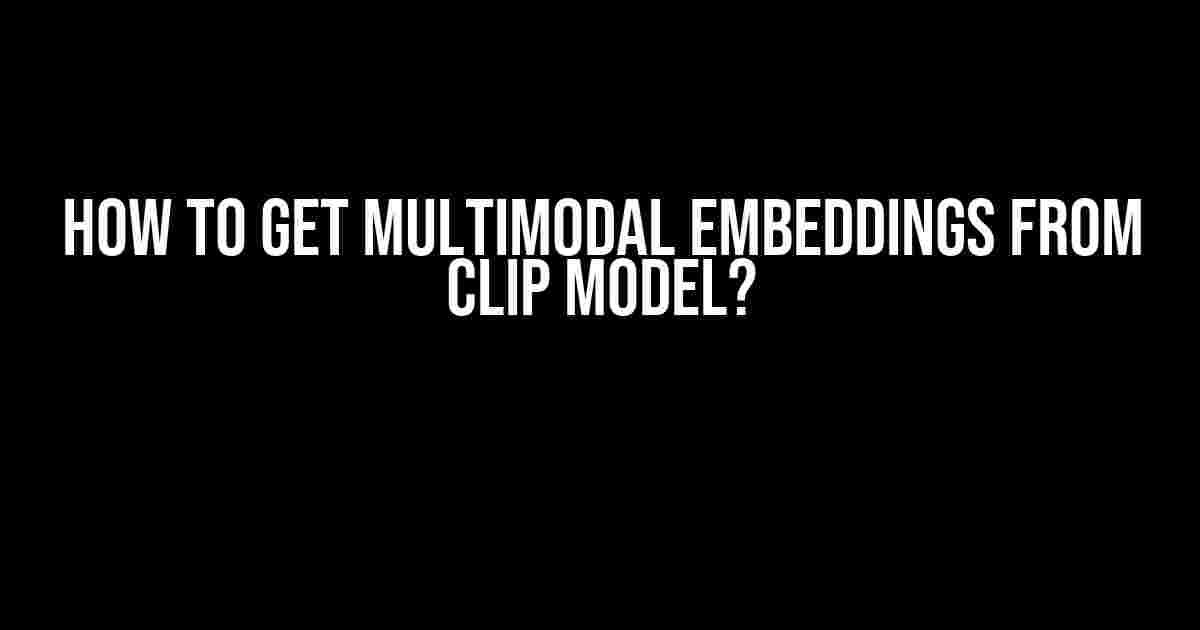The CLIP (Contrastive Language-Image Pre-training) model has revolutionized the field of multimodal learning by providing a powerful tool for learning joint representations of images and texts. One of the key outputs of the CLIP model is the multimodal embedding, which encodes the semantic information of both visual and textual inputs. In this article, we will outline the steps to obtain multimodal embeddings from the CLIP model.
Step 1: Load the Pre-trained CLIP Model
First, you need to load the pre-trained CLIP model using the Hugging Face Transformers library. You can use the following Python code to load the model:
import torch
from transformers import CLIPModel, CLIPTokenizer
model_name = "openai/clip-vit-base-patch16-224"
tokenizer = CLIPTokenizer.from_pretrained(model_name)
model = CLIPModel.from_pretrained(model_name)Step 2: Prepare the Input Data
Next, you need to prepare the input data, which consists of images and corresponding texts. You can use the following Python code to preprocess the input data:
import cv2
import torch
image_path = "image.jpg"
text = "This is a sample text"
image = cv2.imread(image_path)
image = cv2.resize(image, (224, 224))
image = torch.tensor(image).unsqueeze(0)
inputs = tokenizer(text, return_tensors="pt")Step 3: Obtain Multimodal Embeddings
Now, you can use the pre-trained CLIP model to obtain the multimodal embeddings of the input data. You can use the following Python code to get the multimodal embeddings:
with torch.no_grad():
outputs = model.get_text_features(inputs["input_ids"], inputs["attention_mask"])
image_features = model.get_image_features(image)
multimodal_embedding = torch.cat((outputs.last_hidden_state[:, 0, :], image_features.last_hidden_state[:, 0, :]), dim=-1)The resulting `multimodal_embedding` tensor contains the joint representation of the input image and text.
Conclusion
In this article, we have outlined the steps to obtain multimodal embeddings from the CLIP model. By following these steps, you can extract powerful joint representations of images and texts, which can be used for various downstream tasks such as image-text matching, visual question answering, and multimodal retrieval.
Frequently Asked Question
Unlock the power of multimodal embeddings with CLIP – here are the answers to get you started!
What is CLIP and why do I need multimodal embeddings?
CLIP (Contrastive Language-Image Pre-training) is a powerful model that learns to represent images and text in a single embedding space. Multimodal embeddings are essential because they enable models to understand and relate visual and textual data, unlocking a wide range of applications in computer vision, natural language processing, and beyond!
How do I extract multimodal embeddings from a pre-trained CLIP model?
You can extract multimodal embeddings using the `clip.model` module in the transformers library. Simply load a pre-trained CLIP model, preprocess your input data (e.g., images and text), and pass them through the model to obtain the embeddings. Easy peasy!
What are the key differences between image and text embeddings in CLIP?
Image embeddings in CLIP are generated by passing images through a convolutional neural network (CNN), while text embeddings are generated by passing text through a transformer encoder. This allows CLIP to capture both visual and linguistic features in a single embedding space!
Can I fine-tune a pre-trained CLIP model for my specific task?
Yes, you can! Fine-tuning a pre-trained CLIP model can adapt the multimodal embeddings to your specific task, such as image-text retrieval or visual question answering. This can lead to even better performance and more accurate results!
What are some potential applications of multimodal embeddings from CLIP?
The possibilities are endless! Multimodal embeddings from CLIP can be used for image-text retrieval, visual question answering, image generation, and more. You can also explore applications in areas like robotics, healthcare, and education – the sky’s the limit!

